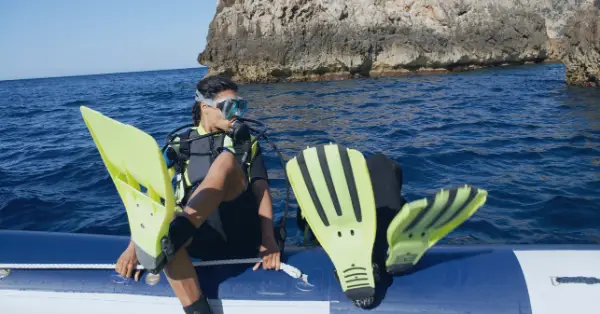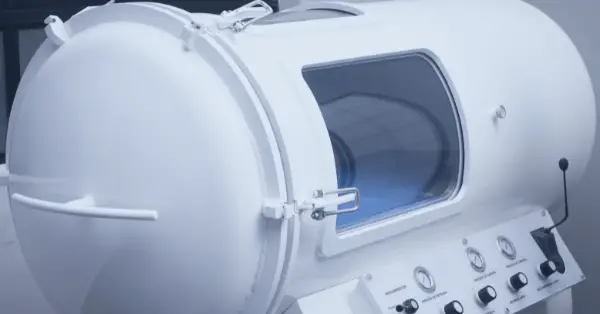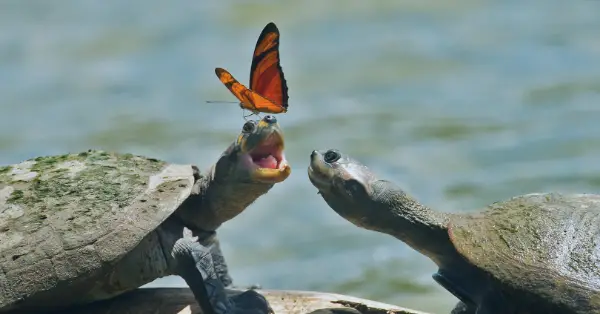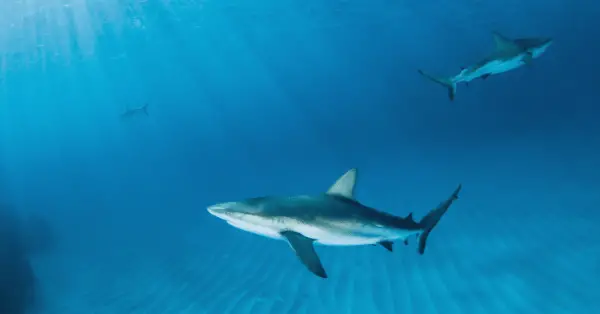Most common birds you can see while scuba diving
If you’re an avid scuba diver, you may have already encountered a variety of marine creatures such as fish, turtles, and sharks. But did you know that there are also birds that you can spot while scuba diving? Yes, that’s right! From pelicans and cormorants to penguins and gannets, there are many species of birds that you can observe underwater.
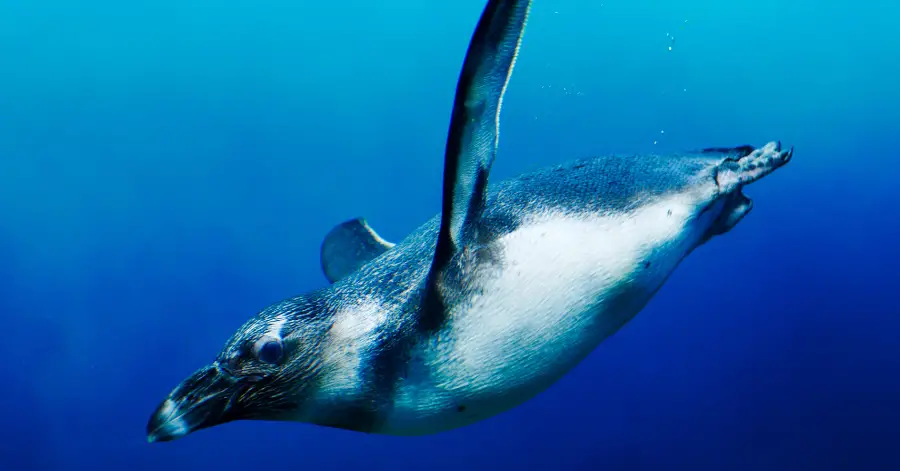
Birds are fascinating creatures that have adapted to their underwater environment in unique ways. Some birds, such as cormorants and penguins, are expert divers who can hold their breath for several minutes and swim at impressive depths. Others, like pelicans, use their beaks to scoop up fish from the water’s surface. In this article, we’ll explore the world of marine avifauna and provide tips on how to observe these creatures safely and responsibly.
Key Takeaways
- You can spot a variety of birds while scuba diving, including cormorants, pelicans, penguins, and gannets.
- Birds have adapted to their underwater environment in unique ways, such as by diving deep or using their beaks to catch fish.
- Observing birds while scuba diving requires proper equipment and techniques, as well as responsible conservation efforts to protect these creatures.
Common Birds Spotted While Scuba Diving
When scuba diving, you may be lucky enough to spot some amazing birds underwater. Here are five common birds you might see while scuba diving:
1. Penguins
Penguins are a favorite among divers, and for good reason. These flightless birds are excellent swimmers and can dive to great depths in search of food.
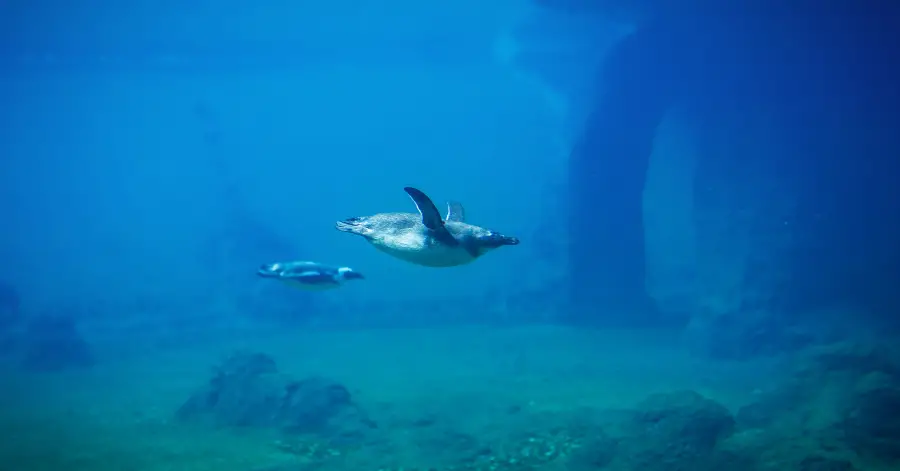
Penguins can only be found in the Southern Hemisphere. They dive mainly for food, with Emperor Penguins reaching depths of over 550 yards (500 meters) and smaller species like the Little Blue Penguin diving up to 65 feet (20 meters). Diving durations vary, with up to 20 minutes for larger species and 1-2 minutes for smaller ones. Known for their distinctive black and white plumage, these birds are agile swimmers and a delight to observe underwater.
Diving behavior of penguins
In the water, penguins are incredibly agile, using their flippers to propel themselves swiftly. They dive to hunt for fish, squid, and krill, often engaging in porpoising – a technique of leaping out of the water to breathe while maintaining speed.
Best places to dive with penguins
- Galápagos Islands: Home to the unique Galápagos Penguin, these islands offer a rare opportunity to see these birds at the equator, where they are often found swimming near the cooler waters around Isabela Island.
- Coastal Australia and New Zealand: These regions are excellent for spotting Little Blue Penguins, especially around areas like Phillip Island, where they are known to frequent.
- South Africa: A popular spot for observing African Penguins is Boulders Beach. This beach provides easy access to see these penguins in their natural habitat, swimming and foraging in the nearby waters.
- Antarctic Regions: The best place to see the majestic Emperor Penguin, diving in these icy waters provides a unique opportunity to witness their impressive deep-diving abilities. However, scuba diving is not a common activity. We just wanted to list it for comprehensive reasons.
Ease of spotting penguins underwater
Spotting penguins while scuba diving can vary in difficulty depending on the location and species. In general, areas where penguins are accustomed to human presence, like Boulders Beach, offer easier viewing opportunities. In more remote or protected areas, such as the Galápagos Islands or Antarctic regions, seeing these birds may require more patience and luck.
Site note: I dove in Isabella and was without luck. I even waited in front of a rock for them to jump in. But the cold waters (62 degrees Fahrenheit/17 Celsius) made me move on – also diving with Iguanas at the same dive site was incredible, too.
The key is to respect their natural habitat and maintain a safe distance, ensuring a memorable and responsible wildlife experience.
2. Cormorants
Cormorants, belonging to the family Phalacrocoracidae, are medium-to-large aquatic birds found around the world, except for the central Pacific islands. They are renowned for their impressive diving skills, diving as deep as 150 feet (45 meters) to catch fish, eels, and water snakes. These birds have dark plumage, long, thin hooked bills, and webbed feet. They are coastal birds, some of which have adapted to inland water habitats.
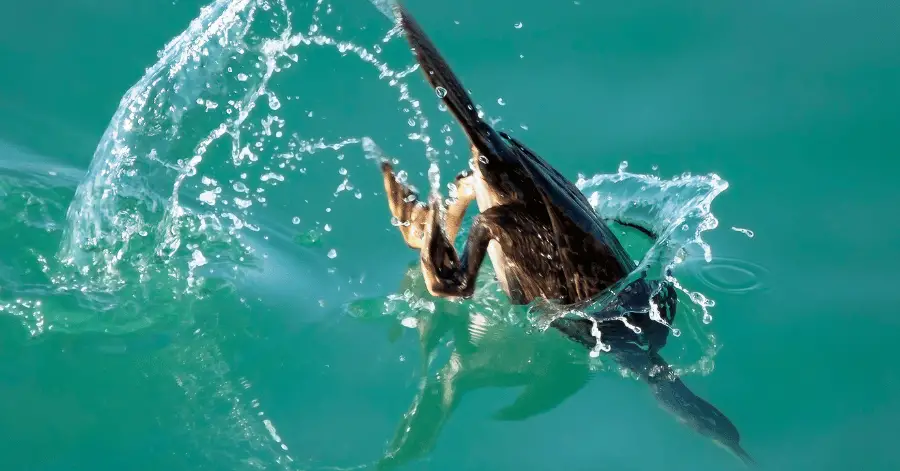
Cormorants diving behavior
Cormorants are exceptional divers. They hunt by diving from the surface, propelling themselves underwater with their feet and sometimes their wings. After fishing, they are often seen ashore with their wings spread out, drying them in the sun.
Best places to dive with cormorants
Cormorants are found in a variety of habitats, from seacoasts to inland waters. Notable diving spots include:
- Coastal areas around the UK and Ireland, where the Great Cormorant and the European Shag are commonly found.
- The Northern Pacific region, home to the Brandt’s Cormorant and the Red-faced Cormorant, known for their deep diving near rocky shores.
- Freshwater lakes and rivers in Central Asia and Europe, where the Pygmy Cormorant can be observed.
These locations offer unique opportunities to observe the diverse hunting and diving behaviors of different cormorant species in their natural habitats.
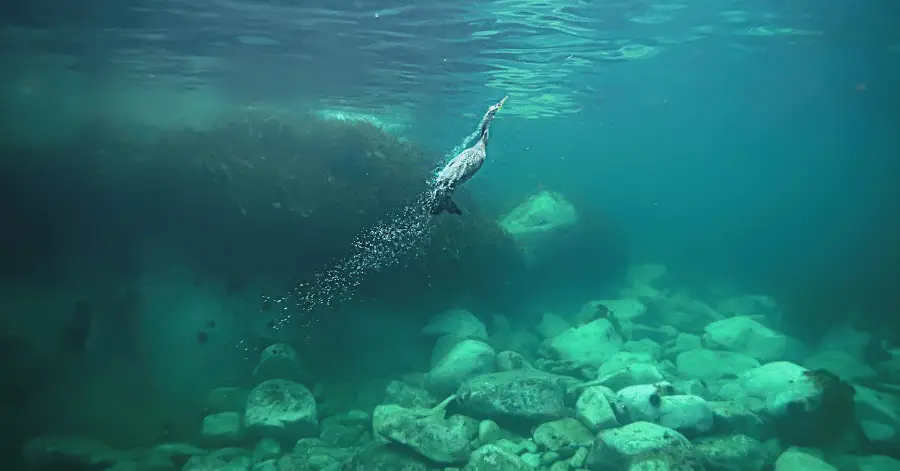
Ease of spotting cormorants underwater
Spotting cormorants while diving can vary depending on the species and location. In coastal areas where they are common, such as around the UK and Northern Pacific, they are relatively easy to spot due to their large colonies and frequent surface diving. Inland waters might require more patience, as species like the Pygmy Cormorant are smaller and less conspicuous. As with all wildlife encounters, patience and respect for the animal’s natural behavior are key to a successful and environmentally conscious diving experience.
3. Pelicans
Pelicans are large water birds famous for their long beaks and large throat pouches, used for scooping up fish. They belong to the genus Pelecanus and the family Pelecanidae.
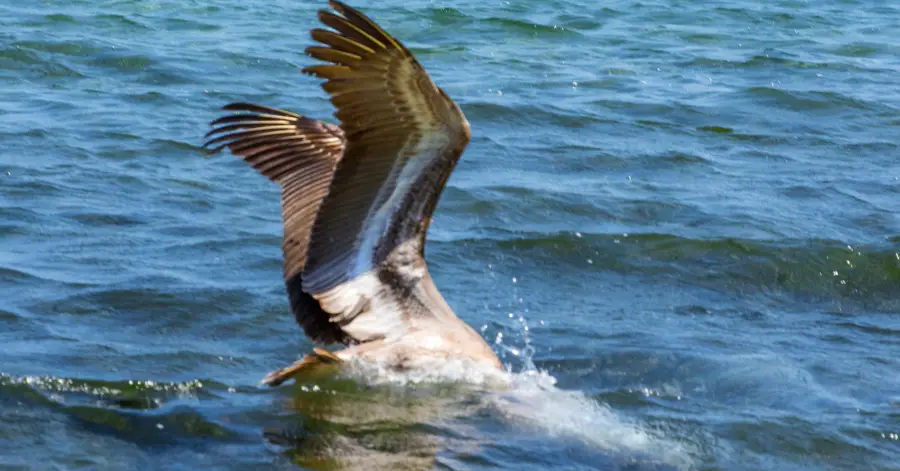
These birds are known for their predominantly pale plumage, with some species like the Brown and Peruvian Pelicans having darker colors. Pelicans are found globally, primarily in warmer regions, and are absent from the polar regions and the open ocean. They are excellent swimmers and are known to dive from the air to catch their prey.
Pelicans diving behavior
Pelicans are known for their spectacular diving technique, where they plunge from heights into the water to catch fish. Unlike cormorants, pelicans do not dive underwater but scoop up fish into their large bill pouches while swimming. After catching fish, they drain the water from their pouches before swallowing their prey.
Best places to dive with pelicans
Pelicans can be found in various habitats, including coastal regions, rivers, and lakes. Notable locations for observing pelicans include:
- Coastal areas of North and South America, especially where Brown and American White Pelicans are prevalent.
- The Great Salt Lake in Utah, USA, is a unique inland site where White Pelicans can be observed.
- Australian coasts and inland waters, where the Australian Pelican is commonly found.
These locations offer opportunities to see pelicans engaging in their characteristic fishing behaviors, often in large, sociable flocks.
Ease of spotting pelicans underwater
While pelicans are not typically observed underwater, they are easily spotted from boats or shores due to their large size and distinctive feeding behavior. In areas where they are common, such as coastal regions and large inland lakes, pelicans can often be seen diving from the air, making them a relatively easy and impressive bird to observe from a distance. Their sociable nature often leads them to form large groups, making them even more visible and accessible for bird watchers and nature enthusiasts.
4. Puffins
Puffins are small, colorful birds that are often seen swimming near the surface of the water. They are excellent divers and can dive to depths of up to 200 feet in search of fish. While scuba diving, you might see them darting through the water, or perched on rocks or other underwater structures.
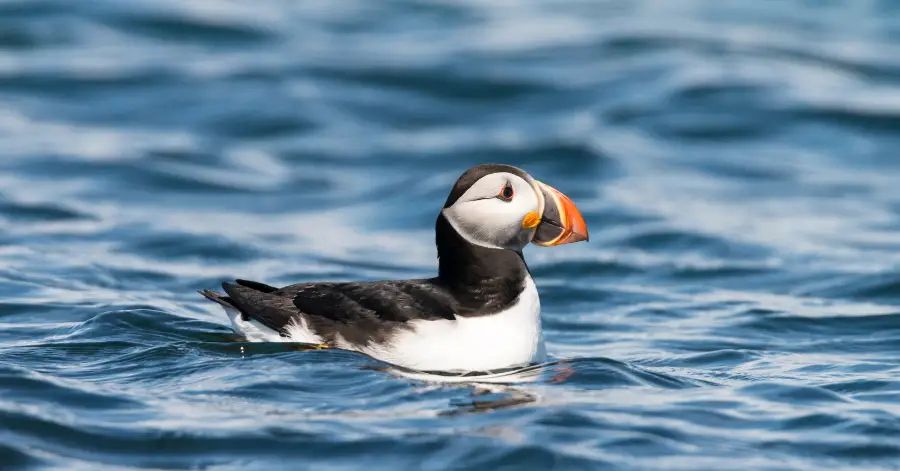
They primarily feed by diving for fish. There are three species of puffins: the Atlantic Puffin (F. arctica), the Horned Puffin (F. corniculata), and the Tufted Puffin (F. cirrhata), found in the North Atlantic and North Pacific Oceans.
Puffins diving behavior
Puffins are known for their remarkable diving ability, propelling themselves underwater with wing strokes. They can stay submerged for up to a minute, often diving to depths of 100 feet (30 meters) to hunt for small fish. On the surface, they are agile and can often be seen bobbing on the water or flying low over the sea.
Best places to dive with puffins
- North Atlantic coasts, especially Iceland and the Faroe Islands, are prime locations for observing the Atlantic Puffin.
- The coasts of Alaska and British Columbia are great for spotting the Horned and Tufted Puffins.
- Puffin Island in Wales and the coasts of Maine in the USA also offer opportunities to see these birds in their natural habitat.
These locations provide not only the chance to observe puffins in their cliffside burrows but also to see them diving and swimming in nearby waters.
Ease of spotting puffins underwater
While puffins are more often observed on land or flying near the surface of the water, spotting them underwater can be challenging due to their swift and deep-diving behavior. However, in areas where they are abundant, such as the coastal waters of Iceland or Alaska, divers and snorkelers may have the opportunity to see these birds as they dive for fish. The best time to observe puffins is during their breeding season when they are more active near their nesting sites on coastal cliffs and islands.
5. Gannets
Gannets are large seabirds from the genus Morus, part of the Sulidae family, closely related to boobies. They are known for their striking appearance: large white bodies with yellowish heads, black-tipped wings, and long bills. Northern gannets are the largest seabirds in the North Atlantic, with wingspans up to six and a half feet (2m). Gannets are renowned for their high-speed dives from heights of 100 feet (30 meters) into the sea to catch fish, reaching speeds of 60 mph (100 km/h).
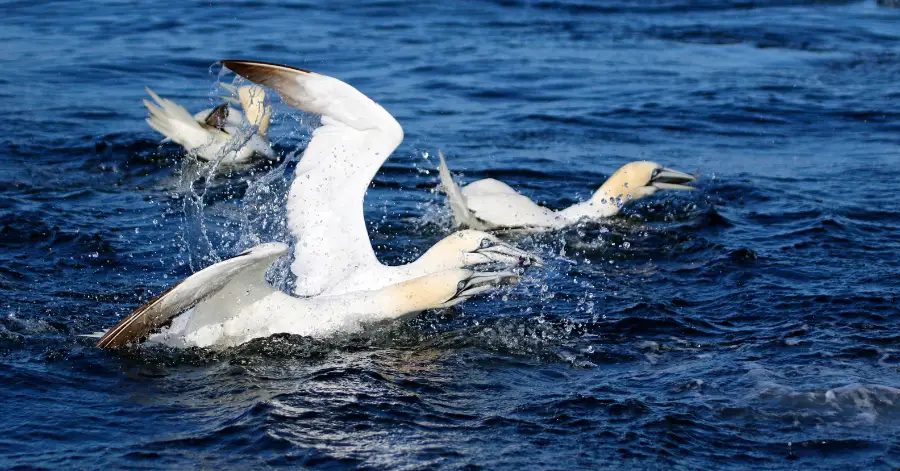
Gannets diving behavior
Gannets are spectacular divers, plunging from great heights into the sea at high speeds. They have several adaptations for this, including air sacs under their skin to cushion the impact with the water and positioned eyes for accurate distance judgment. These adaptations allow them to catch fish at much greater depths than most airborne birds.
Best places to dive with gannets
- The United Kingdom, particularly Scotland, hosts the largest population of northern gannets, with significant colonies on Bass Rock in the Firth of Forth and Bempton Cliffs in Yorkshire.
- Canada, Ireland, the Faroe Islands, and Iceland also have substantial northern gannet populations.
- Southern Africa, southern Australia, and New Zealand are home to the other two gannet species, Morus capensis and Morus serrator.
These locations are ideal for observing gannets, especially during the breeding season when they are most active and gather in large colonies on cliffs and islands.
Ease of spotting gannets underwater
While gannets are more commonly observed from boats or cliffs as they dive into the water, spotting them underwater can be challenging due to their swift diving speeds and the depths they reach. However, in areas where they are abundant, such as around their breeding colonies, it’s possible to see these birds as they plunge into the water. The best time for observation is during the breeding season when they are actively hunting to feed their young.
Best Locations for Bird and Scuba Encounters
If you’re a bird lover and a scuba diver, you’ll be happy to know that there are plenty of locations where you can combine your two passions. Here are some of the best locations around the world where you can see birds while scuba diving.
Tropical Regions
Tropical regions are home to some of the most colorful and exotic bird species in the world. Here are some of the best locations where you can see them while scuba diving:
- Puerto Rico – With over 300 species of birds, including 17 endemic species, Puerto Rico is a paradise for birders. The island’s lush rainforests and tropical climate make it an ideal location for scuba diving as well.
- Belize – Belize is home to over 500 species of birds, including the keel-billed toucan, which is one of the most colorful birds in the world. The country’s barrier reef is also one of the best places in the world for scuba diving.
- Indonesia – Indonesia is home to over 1,700 species of birds, including the famous birds of paradise. The country’s many islands also offer some of the best scuba diving in the world, with vibrant coral reefs and a wide variety of marine life.
Temperate Waters
While tropical regions are known for their colorful birds, temperate waters are home to some of the most majestic and powerful birds in the world. Here are some of the best locations where you can see them while scuba diving:
- Monterey Bay, California – Monterey Bay is home to a variety of seabirds, including the California brown pelican. These birds can often be seen flying in a V-formation or in a line when you’re prepping for a dive at the beach.
- Cape Town, South Africa – Cape Town is home to a variety of seabirds, including the African penguin, which is one of the most endangered penguin species in the world. The area is also known for its great white shark diving.
- The Galapagos Islands – The Galapagos Islands are home to a variety of bird species, including the famous blue-footed booby. The islands are also known for their incredible marine life, making them a popular destination for scuba divers.
No matter where you choose to go, combining bird watching and scuba diving is a unique and rewarding experience that you won’t soon forget.
Birds’ Underwater Behaviors
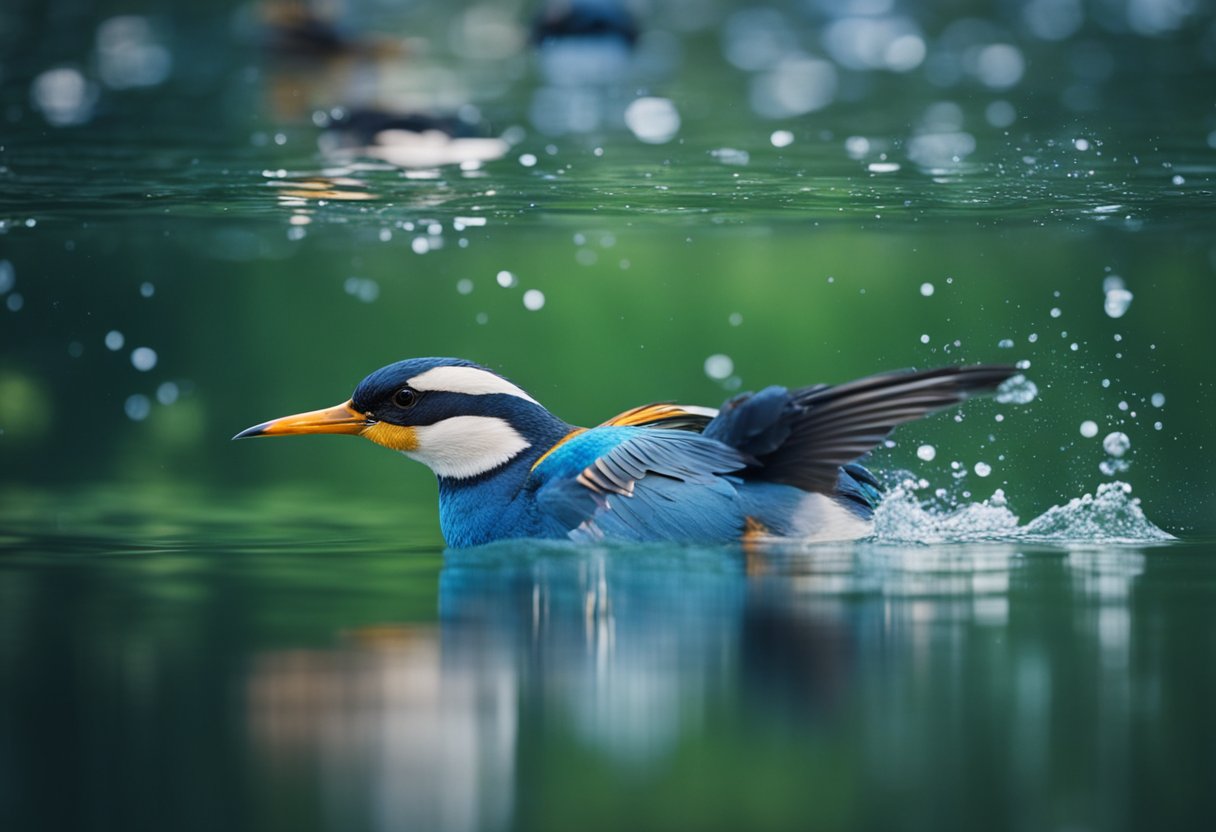
If you are a scuba diver, you may be surprised to know that some birds can be spotted underwater. These birds have adapted to diving and swimming in the ocean to catch their prey. Here are some of the behaviors you can observe while scuba diving.
Hunting Techniques
Birds have different hunting techniques when they are underwater. For example, cormorants use their feet to propel themselves underwater while using their wings to steer. They can dive up to 150 feet (45 meters) deep and stay underwater for up to a minute. Puffins, on the other hand, use their wings to swim underwater and catch small fish. They can dive up to 200 feet (60 meters) deep and stay underwater for up to a minute and a half.
Diving Depths
Different birds have different diving depths. For example, the brown pelican can dive from as high as 100 feet and plunge into the water to catch fish. They can hold their breath for up to 30 seconds underwater. The osprey, also known as a fish hawk, can dive feet first into the water and catch fish with their talons. They can dive up to 3 feet deep and stay underwater for up to 30 seconds.
Interactions with Marine Life
Birds that dive underwater can interact with marine life in different ways. For example, gannets dive into the water at high speeds and catch fish in their beaks. They can dive up to 100 feet (30 meters) deep and stay underwater for up to a minute. They sometimes swim with dolphins and other marine animals. Boobies, another type of diving bird, can be seen swimming and diving underwater to catch their prey. They can stay underwater for up to a minute and a half and sometimes swim with sea turtles.
Overall, observing birds underwater can be a fascinating experience while scuba diving. Remember to keep a safe distance and avoid disturbing their natural habitat.
Equipment and Techniques for Bird Observation Underwater
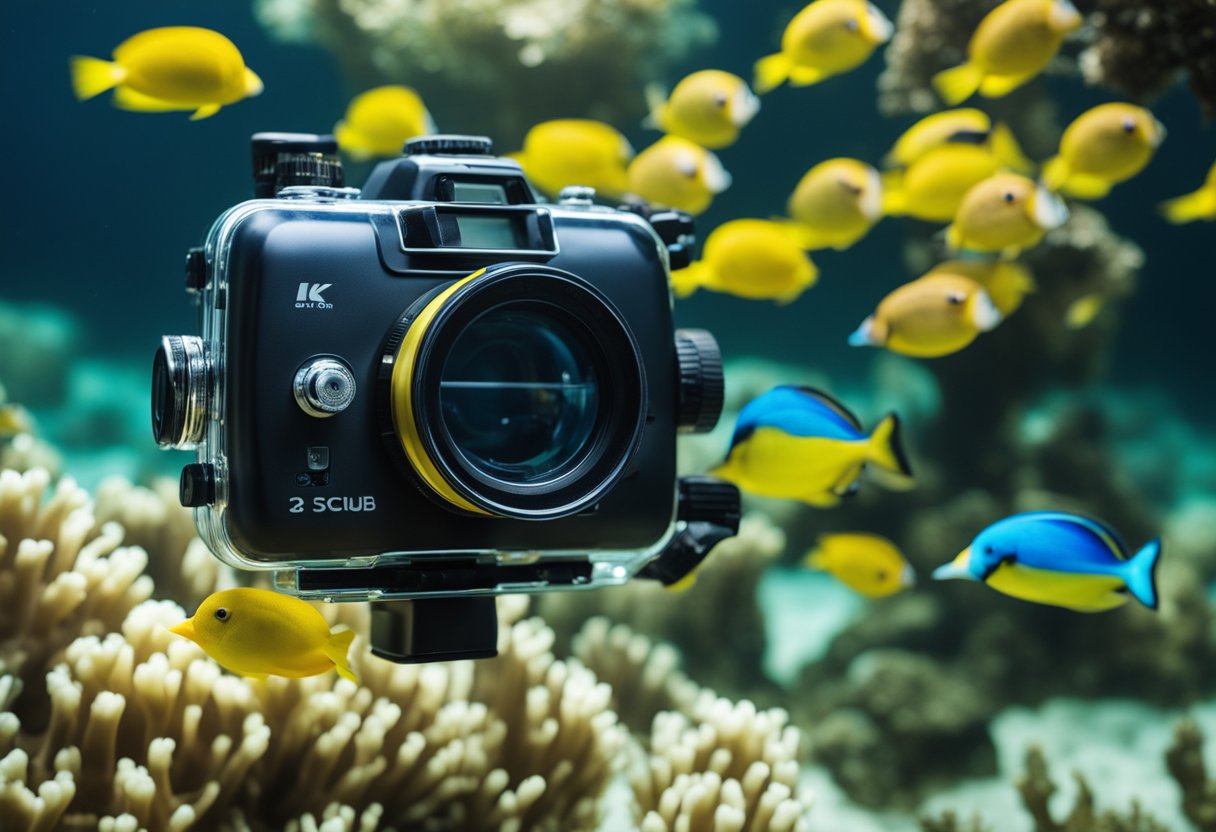
If you want to observe birds while scuba diving, you’ll need to bring the right equipment and use the right techniques. Here are some tips to help you get started:
Equipment
- Underwater camera: You’ll need an underwater camera to take photos of the birds you see. Look for a camera that is designed for scuba diving and has a fast shutter speed and good low-light performance.
- Scuba gear: Obviously, you’ll need scuba gear to dive underwater. Make sure your gear is in good condition and that you have all the necessary items, such as fins, a mask, and a regulator.
- Binoculars: You might also want to bring a pair of binoculars to help you spot birds from a distance.
Techniques
- Stay still: When you’re underwater, it’s important to stay as still as possible so you don’t scare away the birds. Move slowly and avoid sudden movements.
- Look for hiding spots: Birds often hide in rocks and crevices, so keep an eye out for these areas.
- Use natural camouflage: You can also use natural camouflage to help you blend in with your surroundings. Wear a wetsuit that matches the color of the water, and try to move in a way that mimics the movement of the waves.
- Be patient: Finally, remember that bird observation is a waiting game. You might have to wait for a while to see the birds you’re looking for, so be patient and stay focused.
Conservation Efforts for Marine Avifauna
When scuba diving, you may have the opportunity to spot various species of birds that are adapted to living in marine environments. However, these birds are facing various threats, including habitat loss, pollution, and overfishing. As a result, several conservation efforts have been put in place to protect these birds and their habitats.
One such effort is the Mariana Avifauna Conservation Program. This program aims to translocate endangered bird species from Saipan and Tinian to uninhabited northern islands, in hopes of establishing founder populations. Additionally, the program manages viable populations within AZA institutions. By protecting these birds and their populations, the program helps to maintain the ecological balance of the marine environment.
Another way you can help protect marine avifauna is by participating in clean-up efforts. Marine debris and plastic pollution can have devastating effects on bird populations. By participating in beach clean-ups, you can help to remove this debris from the environment and prevent it from harming birds.
Finally, it is important to be mindful of your actions when scuba diving. Avoid disturbing bird habitats and nesting areas, and steer clear of dive shops that sell or display anything made from marine wildlife. By taking these simple steps, you can help to protect the marine environment and the birds that call it home.
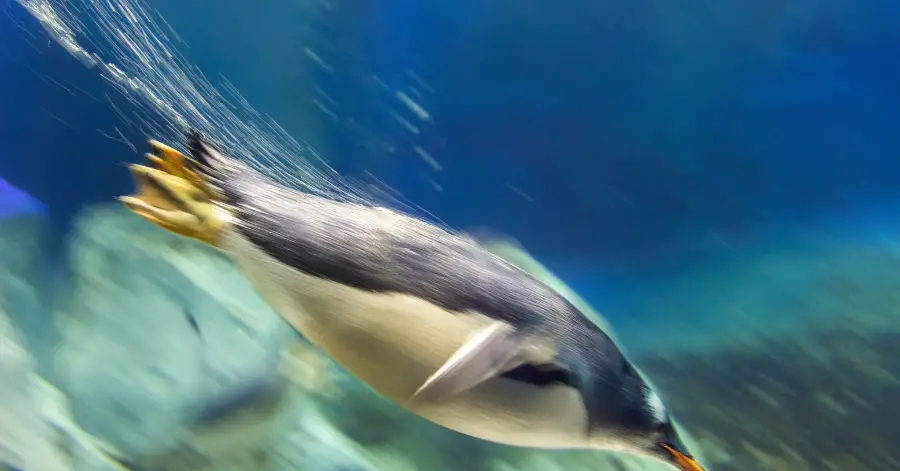
Frequently Asked Questions
What species of birds are known for their ability to dive into water to catch fish?
Several species of birds are known for their ability to dive into water to catch fish. These birds are called plunge-divers or pelagic divers. Some examples of plunge-divers include cormorants, gannets, and boobies. These birds have streamlined bodies and powerful wings that allow them to dive deep into the water to catch fish.
Where can I scuba dive with penguins?
If you want to scuba dive with penguins, you can visit the Galapagos Islands or Antarctica. The Galapagos Islands are home to the Galapagos penguin, which is the only penguin species found north of the equator. In Antarctica, you can dive with several species of penguins, including the Adélie, chinstrap, and gentoo penguins.
Which birds can you see while scuba diving in Galapagos?
The Galapagos Islands are home to a variety of bird species that can be seen while scuba diving. In addition to the Galapagos penguin, you can also see flightless cormorants, blue-footed boobies, Nazca boobies, and red-billed tropicbirds. These birds are adapted to life on the islands and have unique behaviors and characteristics.
Which birds are commonly seen diving underwater in Floridian waters?
In Floridian waters, you can see several species of birds that are commonly seen diving underwater. Some examples include brown pelicans, double-crested cormorants, and anhingas. These birds dive underwater to catch fish, and they can be seen diving from the surface or flying overhead.
Which small birds are recognized for their diving habits to forage for fish?
Kingfishers are small birds that are recognized for their diving habits to forage for fish. These birds have long, pointed bills that they use to catch fish underwater. They are found in many parts of the world, including North and South America, Europe, and Asia.
What are some characteristics of plunge-diving birds?
Plunge-diving birds have several characteristics that make them well-suited for diving into water to catch fish. These birds have streamlined bodies and powerful wings that allow them to dive deep into the water. They also have air sacs in their bodies that help them control their buoyancy and avoid injury when diving.
Are there any birds that can remain submerged for extended periods, such as 20 minutes?
There are no birds that can remain submerged for extended periods, such as 20 minutes. While some birds can hold their breath for several minutes, they must come up for air eventually. Birds that dive underwater have adaptations that allow them to stay underwater for longer periods, but they still need to breathe air to survive.

